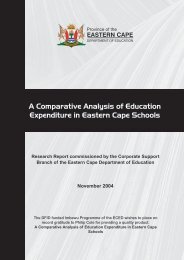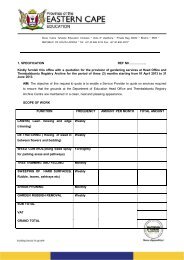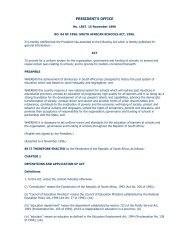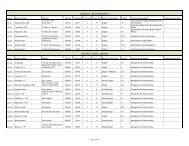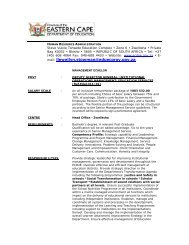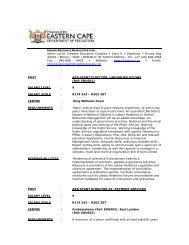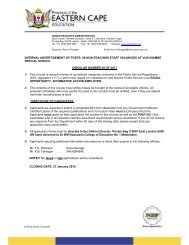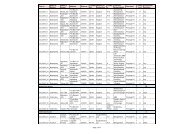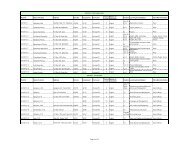NATIONAL SENIOR CERTIFICATE GRAAD 12 GRADE 12
NATIONAL SENIOR CERTIFICATE GRAAD 12 GRADE 12
NATIONAL SENIOR CERTIFICATE GRAAD 12 GRADE 12
You also want an ePaper? Increase the reach of your titles
YUMPU automatically turns print PDFs into web optimized ePapers that Google loves.
<strong>GRAAD</strong> <strong>12</strong><br />
<strong>NATIONAL</strong><br />
<strong>SENIOR</strong> <strong>CERTIFICATE</strong><br />
<strong>GRADE</strong> <strong>12</strong><br />
GEOGRAPHY P1<br />
NOVEMBER 2010<br />
MARKS: 300<br />
TIME: 3 hours<br />
This question paper consists of 14 pages and a 17-page annexure.<br />
*GEOGE1*<br />
Copyright reserved<br />
Please turn over
Geography/P1 2<br />
DBE/November 2010<br />
NSC<br />
INSTRUCTIONS AND INFORMATION<br />
1.<br />
2.<br />
3.<br />
4.<br />
5.<br />
6.<br />
7.<br />
8.<br />
9.<br />
10.<br />
11.<br />
The question paper consists of FOUR questions.<br />
Answer ANY THREE questions of 100 marks each.<br />
ALL diagrams are included in the ANNEXURE.<br />
Number ALL your answers in the CENTRE of the line.<br />
Leave a line open between subsections of questions answered.<br />
Start each question at the top of a NEW page.<br />
Number the answers correctly according to the numbering system used in this<br />
question paper.<br />
Do NOT write in the margins of your ANSWER BOOK.<br />
ENCIRCLE the numbers of the questions that you have answered on the front<br />
page of your ANSWER BOOK.<br />
Where possible, illustrate your answers with labelled diagrams.<br />
Write clearly and legibly.<br />
Copyright reserved<br />
Please turn over
Geography/P1 3<br />
DBE/November 2010<br />
NSC<br />
SECTION A: CLIMATE AND WEATHER, FLUVIAL PROCESSES AND<br />
STRUCTURAL LANDFORMS<br />
Answer at least ONE question from this section.<br />
QUESTION 1<br />
1.1 Refer to FIGURE 1.1 showing global pressure belts and winds. Various<br />
options are given as possible answers to the following questions. Choose the<br />
answer and write only the letter (A – D) next to the question number<br />
(1.1.1 – 1.1.5) in the ANSWER BOOK, for example 1.1.6 A.<br />
1.1.1 FIGURE 1.1 illustrates … circulation.<br />
A<br />
B<br />
C<br />
D<br />
primary<br />
secondary<br />
tertiary<br />
upper atmospheric<br />
1.1.2 Convergence occurs in this area to form the ITCZ:<br />
A<br />
B<br />
C<br />
D<br />
W<br />
X<br />
Y<br />
Z<br />
1.1.3 The westerlies and polar winds converge here to form the polar<br />
front:<br />
A<br />
B<br />
C<br />
D<br />
W<br />
X<br />
Y<br />
Z<br />
1.1.4 The northwesterlies diverge from this pressure belt:<br />
A<br />
B<br />
C<br />
D<br />
W<br />
X<br />
Y<br />
Z<br />
1.1.5 This area is associated with the origin of the polar easterlies:<br />
A<br />
B<br />
C<br />
D<br />
W<br />
X<br />
Y<br />
Z (5 x 2) (10)<br />
Copyright reserved<br />
Please turn over
Geography/P1 4<br />
DBE/November 2010<br />
NSC<br />
1.2 Refer to FIGURE 1.2 showing a river system. Complete the following by<br />
filling in the missing word(s). Choose from the list below and write only the<br />
word(s) next to the question number (1.2.1 – 1.2.5) in the ANSWER BOOK.<br />
confluence; source; interfluve; catchment; dendritic; river mouth; trellis;<br />
watershed<br />
1.2.1 ... A area of a drainage basin which supplies a river with<br />
water<br />
1.2.2 ... B point where two or more streams meet<br />
1.2.3 ... C high-lying area that separates two streams within the<br />
same drainage basin<br />
1.2.4 ... D high-lying area forming the boundary of a drainage<br />
basin<br />
1.2.5 ... E drainage pattern that has developed at E<br />
1.3 Study the information on tropical cyclone Fanele in FIGURE 1.3 before<br />
answering the questions below.<br />
(5 x 2) (10)<br />
1.3.1<br />
1.3.2<br />
1.3.3<br />
1.3.4<br />
1.3.5<br />
1.3.6<br />
State ONE condition that would have favoured the initial<br />
development of tropical cyclone Fanele. (1 x 2)<br />
Give ONE piece of evidence from the satellite image to suggest<br />
that tropical cyclone Fanele is in its mature stage. (1 x 2)<br />
Why does tropical cyclone Fanele generally move from east to<br />
west? (1 x 2)<br />
Explain why tropical cyclone Fanele weakens when it moves over<br />
the southern highlands of Madagascar. (2 x 2)<br />
What was the duration of tropical cyclone Fanele? (1 x 2)<br />
Give TWO reasons why the impact of tropical cyclones on human<br />
life is more severe in developing than in developed countries.<br />
(2 x 2)<br />
(2)<br />
(2)<br />
(2)<br />
(4)<br />
(2)<br />
(4)<br />
1.4 Refer to the source material in FIGURE 1.4 based on the climate summit held<br />
in Copenhagen.<br />
1.4.1<br />
1.4.2<br />
1.4.3<br />
Copyright reserved<br />
Name the greenhouse gas being emitted into the urban<br />
environment in Cartoon A. (1 x 2)<br />
Besides industrial activity, explain TWO other factors that<br />
contribute to high temperatures in urban environments. (2 x 2)<br />
Identify the greenhouse gas, associated with farming activities<br />
(Cartoon B), that is emitted into the atmosphere. (1 x 2)<br />
Please turn over<br />
(2)<br />
(4)<br />
(2)
Geography/P1 5<br />
DBE/November 2010<br />
NSC<br />
1.4.4<br />
1.4.5<br />
More severe flooding is an indirect result of increased greenhouse<br />
gases in the atmosphere. Name TWO negative effects of flooding<br />
on farming activities. (2 x 2)<br />
Environmental groups were not happy with the decisions taken in<br />
respect of global warming at the Copenhagen Accord/Summit.<br />
With reference to Cartoon D, write a single paragraph (no longer<br />
than <strong>12</strong> lines), discussing possible solutions that delegates from<br />
developing countries could have proposed to reduce global<br />
warming. (6 x 2)<br />
(4)<br />
(<strong>12</strong>)<br />
1.5 FIGURE 1.5 contains information on a type of mass movement (mudslide).<br />
1.5.1<br />
1.5.2<br />
1.5.3<br />
1.5.4<br />
1.5.5<br />
What evidence in the sketch indicates that a mudslide has<br />
occurred? (1 x 2)<br />
How was typhoon Morakot responsible for triggering the mudslide<br />
in Taiwan? (1 x 2)<br />
State the economic impact of mass movements on small villages<br />
like the one in Taiwan. (2 x 2)<br />
Suggest TWO ways in which humans are responsible for causing<br />
mass movements. (2 x 2)<br />
Explain any TWO precautionary measures (methods) that people<br />
should adopt (put in place) before using slopes for development.<br />
(2 x 2)<br />
(2)<br />
(2)<br />
(4)<br />
(4)<br />
(4)<br />
1.6 Refer to FIGURE 1.6 which shows a river system and its flow hydrograph.<br />
1.6.1<br />
1.6.2<br />
1.6.3<br />
1.6.4<br />
1.6.5<br />
What is a river system? (1 x 2)<br />
Explain how the following factors influence the amount of water<br />
(discharge) that flows in the stream:<br />
(a) Impermeable bedrock (1 x 2)<br />
(b) Dense vegetation (1 x 2)<br />
Determine the stream order at point X where the stream flows out<br />
of the drainage basin. (1 x 2)<br />
What evidence suggests that this is a superimposed stream?<br />
(1 x 2)<br />
State the lag time on the flow hydrograph. (1 x 2)<br />
(2)<br />
(2)<br />
(2)<br />
(2)<br />
(2)<br />
(2)<br />
1.6.6<br />
Copyright reserved<br />
The proposed development of a new urban settlement along the<br />
stream would influence the flow characteristics of the stream.<br />
Write a single paragraph (no longer than <strong>12</strong> lines) describing, with<br />
reasons, how the proposed urban development along the stream<br />
will change the lag time and the flood peak indicated on the flow<br />
hydrograph. (6 x2)<br />
Please turn over<br />
(<strong>12</strong>)<br />
[100]
Geography/P1 6<br />
DBE/November 2010<br />
NSC<br />
QUESTION 2<br />
2.1 Refer to FIGURE 2.1 showing the tri-cellular arrangement of atmospheric<br />
circulation. Match each statement below with the Hadley/tropical, Ferrel/midlatitude<br />
or polar cell.<br />
2.1.1<br />
2.1.2<br />
2.1.3<br />
2.1.4<br />
2.1.5<br />
Convergence of surface air causes uplift along the equator.<br />
Occurs between 60° – 90° N of the equator.<br />
Air in the upper atmosphere is heated as it moves towards the<br />
equator.<br />
This is a heat-generated cell of circulation.<br />
Develops on the northern side of the polar front. (5 x 2) (10)<br />
2.2 Study FIGURE 2.2 showing a photograph of a section of a river. Various<br />
options are given as possible answers to the following questions. Choose the<br />
answer and write only the letter (A – D) next to the question number<br />
(2.2.1 – 2.2.5) in the ANSWER BOOK, for example 2.2.6 A..<br />
2.2.1 The feature labelled Y is a/an …<br />
A<br />
B<br />
C<br />
D<br />
undercut slope.<br />
slip-off slope.<br />
ox-bow lake.<br />
dip slope.<br />
2.2.2 The section of the river shown in the photograph is in its … course.<br />
A<br />
B<br />
C<br />
D<br />
upper<br />
middle<br />
lower<br />
base<br />
2.2.3 During a flood the river is likely to break through at point Z,<br />
resulting in the formation of a/an …<br />
A<br />
B<br />
C<br />
D<br />
rapid.<br />
ox-bow lake.<br />
meander.<br />
floodplain.<br />
2.2.4 The river shown in this photograph flows throughout the year and is<br />
therefore referred to as …<br />
Copyright reserved<br />
A<br />
B<br />
C<br />
D<br />
episodic.<br />
permanent/perennial.<br />
seasonal.<br />
periodic.<br />
Please turn over
Geography/P1 7<br />
DBE/November 2010<br />
NSC<br />
2.2.5 The river shown in this photograph displays a … stream channel<br />
pattern.<br />
A<br />
B<br />
C<br />
D<br />
dendritic<br />
braided<br />
rock-controlled<br />
meandering (5 x 2) (10)<br />
2.3 Refer to the synoptic weather map in FIGURE 2.3 and answer the questions<br />
below.<br />
2.3.1<br />
2.3.2<br />
2.3.3<br />
2.3.4<br />
2.3.5<br />
2.3.6<br />
2.3.7<br />
Identify the low pressure cell labelled A. (1 x 2)<br />
Indicate why the surface winds that diverge out of cell B are dry<br />
and cold. (1 x 2)<br />
Which of the mid-latitude cyclones, labelled C and D, originated<br />
first? (1 x 2)<br />
Give ONE reason for your answer to QUESTION 2.3.3. (1 x 2)<br />
Give the term used to describe a series of mid-latitude cyclones<br />
passing over an area in quick succession. (1 x 2)<br />
Name TWO effects of mid-latitude cyclones on farming in the<br />
Southwestern Cape. (2 x 2)<br />
What will happen to low-pressure cell A if mid-latitude cyclone C<br />
moves further eastwards? (1 x 2)<br />
(2)<br />
(2)<br />
(2)<br />
(2)<br />
(2)<br />
(4)<br />
(2)<br />
2.4 Refer to FIGURE 2.4 showing the development of the South African berg<br />
wind. Strong subsidence over the plateau of South Africa results in a well<br />
developed high-pressure cell over the interior that will result in specific<br />
weather conditions there.<br />
2.4.1<br />
2.4.2<br />
2.4.3<br />
2.4.4<br />
2.4.5<br />
Name the high-pressure cell visible in FIGURE 2.4, that results<br />
from subsidence over the plateau. (1 x 2)<br />
How does the berg wind affect the weather along the southeast<br />
coast of South Africa? (2 x 2)<br />
Name the environmental hazard associated with the development<br />
of berg winds. (1 x 2)<br />
State ONE possible measure that can be introduced to reduce the<br />
impact of the environmental hazard named in QUESTION 2.4.3<br />
(1 x 2)<br />
During which season do berg winds mainly affect the weather<br />
along the southeast coast of South Africa? (1 x 2)<br />
(2)<br />
(4)<br />
(2)<br />
(2)<br />
(2)<br />
Copyright reserved<br />
Please turn over
Geography/P1 8<br />
DBE/November 2010<br />
NSC<br />
2.4.6 The high-pressure cell over the interior can result in drought which<br />
is a common climatic hazard in large parts of South Africa. Write a<br />
single paragraph (no more than <strong>12</strong> lines) in which you evaluate the<br />
effects of droughts in South Africa. In your answer refer to the<br />
environment and economic activities. (6 x 2) (<strong>12</strong>)<br />
2.5 FIGURE 2.5 illustrates a structural landscape typically found in the Karoo.<br />
2.5.1<br />
2.5.2<br />
2.5.3<br />
2.5.4<br />
2.5.5<br />
Identify landforms P and Q respectively. (2 x 2)<br />
What evidence in FIGURE 2.5 suggests that landforms P and Q<br />
developed from the same landform that existed earlier? (1 x 2)<br />
Which rock type in FIGURE 2.5 is the most resistant to erosion?<br />
(1 x 2)<br />
Give ONE reason for your answer to QUESTION 2.5.3. (1 x 2)<br />
Briefly describe how landform P will change into landform Q. (3 x 2)<br />
(4)<br />
(2)<br />
(2)<br />
(2)<br />
(6)<br />
2.6 FIGURE 2.6 illustrates the concept of river capture/stream piracy.<br />
2.6.1<br />
2.6.2<br />
2.6.3<br />
2.6.4<br />
2.6.5<br />
Name ONE factor which could have resulted in the Berg River<br />
eroding through the watershed to capture the Kort River. (1 x 2)<br />
Name TWO features of river capture that could develop at point X.<br />
(2 x 2)<br />
Why is the beheaded stream (Kort River) in sketch B referred to as<br />
a misfit stream? (1 x 2)<br />
Name TWO effects that river capture has on the captor stream<br />
(Berg River) in sketch B. (2 x 2)<br />
Write a single paragraph (no more than <strong>12</strong> lines) presenting a<br />
detailed report on how river capture influences human activities<br />
along the Kort and the Berg Rivers respectively. (6 x 2)<br />
(2)<br />
(4)<br />
(2)<br />
(4)<br />
(<strong>12</strong>)<br />
[100]<br />
Copyright reserved<br />
Please turn over
Geography/P1 9<br />
DBE/November 2010<br />
NSC<br />
SECTION B: PEOPLE AND PLACES: RURAL AND URBAN SETTLEMENTS,<br />
PEOPLE AND THEIR NEEDS<br />
Answer at least ONE question from this section.<br />
QUESTION 3<br />
3.1 Refer to FIGURE 3.1 illustrating settlement patterns. Indicate whether the<br />
following statements are TRUE or FALSE. Choose the answer and write<br />
down only 'true' or 'false' next to the question number (3.1.1 – 3.1.5) in the<br />
ANSWER BOOK.<br />
3.1.1<br />
3.1.2<br />
3.1.3<br />
3.1.4<br />
3.1.5<br />
FIGURE 3.1 illustrates urban settlements.<br />
C developed a linear shape.<br />
B represents isolated farmsteads.<br />
A shows a dispersed/isolated pattern.<br />
D shows a randomly dispersed pattern. (5 x 2) (10)<br />
3.2 Choose a statement from COLUMN B that matches a term from COLUMN A.<br />
Write down only the letter (A – G) next to the question number (3.2.1 – 3.2.5)<br />
in the ANSWER BOOK, for example 3.2.6 H.<br />
3.2.1<br />
COLUMN A<br />
Gross domestic product<br />
A<br />
COLUMN B<br />
value added to raw materials<br />
3.2.2<br />
3.2.3<br />
3.2.4<br />
3.2.5<br />
Tertiary activity<br />
Informal sector<br />
Balance of trade<br />
Multi-national corporation<br />
B<br />
C<br />
D<br />
company which has outlets/shops<br />
in different countries<br />
provision of services<br />
value of all goods and services<br />
produced in a country in one year<br />
E<br />
value of all finished goods and<br />
services produced by a country's<br />
permanent inhabitants in one<br />
year<br />
F<br />
the trade involving businesses<br />
not registered with the<br />
government and occupying<br />
premises illegally<br />
G<br />
the difference in value between a<br />
country's imports and exports<br />
(5 x 2) (10)<br />
Copyright reserved<br />
Please turn over
Geography/P1 10<br />
DBE/November 2010<br />
NSC<br />
3.3 Rapid urban expansion has had a major impact (influence) on large cities in<br />
South Africa. Refer to FIGURE 3.3 based on the process of urbanisation.<br />
3.3.1<br />
3.3.2<br />
3.3.3<br />
3.3.4<br />
3.3.5<br />
3.3.6<br />
Define the term urban expansion. (1 x 2)<br />
What message is the cartoonist trying to convey (get across) to us<br />
about the expansion of cities? (1 x 2)<br />
What do you understand by the term megalopolis? (1 x 2)<br />
Give the geographical term used to describe the uncontrolled<br />
expansion of a residential area on the outskirts of an urban area.<br />
(1 x 2)<br />
State TWO challenges that city councils experience with regard to<br />
the expansion of cities. (2 x 2)<br />
Suggest TWO environmentally-friendly measures to prevent<br />
uncontrolled urban expansion. (2 x 2)<br />
(2)<br />
(2)<br />
(2)<br />
(2)<br />
(4)<br />
(4)<br />
3.4 Refer to FIGURE 3.4 showing the cycle of rural decay which also occurs in<br />
the South African landscape. This often results in rural-urban migration<br />
resulting in specific problems for rural areas.<br />
3.4.1<br />
3.4.2<br />
3.4.3<br />
3.4.4<br />
Define the term rural-urban migration. (1 x 2)<br />
Name TWO push factors that may result in rural-urban migration.<br />
(2 x 2)<br />
Discuss THREE consequences (results) of rural-urban migration<br />
for the South African rural community. (3 x 2)<br />
Write a single paragraph (no more than <strong>12</strong> lines) in which you<br />
discuss sustainable strategies that can be used to manage South<br />
Africa's declining rural settlements. (6 x 2)<br />
(2)<br />
(4)<br />
(6)<br />
(<strong>12</strong>)<br />
3.5 Refer to FIGURE 3.5 showing South Africa's largest industrial region.<br />
3.5.1<br />
3.5.2<br />
3.5.3<br />
3.5.4<br />
Identify the industrial region shown in FIGURE 3.5. (1 x 2)<br />
Name any ONE of the dominant industrial activities found in the<br />
industrial region mentioned in QUESTION 3.5.1. (1 x 2)<br />
Discuss any THREE factors that favoured industrial development in<br />
the industrial region illustrated in FIGURE 3.5. (3 x 2)<br />
Discuss THREE problems associated with industrial development<br />
in the industrial region illustrated in FIGURE 3.5. (3 x 2)<br />
(2)<br />
(2)<br />
(6)<br />
(6)<br />
Copyright reserved<br />
Please turn over
Geography/P1 11<br />
DBE/November 2010<br />
NSC<br />
3.6 Read the extract in FIGURE 3.6 before answering the following questions.<br />
3.6.1<br />
3.6.2<br />
3.6.3<br />
3.6.4<br />
3.6.5<br />
QUESTION 4<br />
What is a bi-national construction project? (1 x 2)<br />
Define the term water-transfer scheme. (1 x 2)<br />
With reference to the water resources of South Africa, give TWO<br />
reasons why the country initiated (started) the development of the<br />
Lesotho Highlands Water Project. (2 x 2)<br />
With reference to the quality of life of the people of Lesotho,<br />
evaluate TWO possible injustices (problems) associated with the<br />
development of the Lesotho Highlands Water Project. (2 x 2)<br />
Despite the above-mentioned injustices, both Lesotho and South<br />
Africa gained from the development of the Lesotho Highland Water<br />
Project. Write a single paragraph (no more than <strong>12</strong> lines) to<br />
discuss the advantages of the Lesotho Highlands Water project for<br />
both Lesotho and South Africa. (6 x 2)<br />
(2)<br />
(2)<br />
(4)<br />
(4)<br />
(<strong>12</strong>)<br />
[100]<br />
4.1 Refer to FIGURE 4.1 illustrating the population of urban centres and the<br />
number of functions they offer. Indicate whether the following statements are<br />
TRUE or FALSE. Choose the answer and write down only 'true' or 'false' next<br />
to the question number (4.1.1 – 4.1.5) in the ANSWER BOOK.<br />
4.1.1<br />
4.1.2<br />
4.1.3<br />
4.1.4<br />
4.1.5<br />
The larger the urban centre, the fewer the urban functions offered.<br />
Urban centres C and D are central places.<br />
The urban centres at E have a larger sphere of influence than the<br />
urban centres at B.<br />
The urban centres at E have a larger range than the urban centres<br />
at F.<br />
The urban centre at A provides mainly low-order service functions.<br />
(5 x 2) (10)<br />
Copyright reserved<br />
Please turn over
Geography/P1 <strong>12</strong><br />
DBE/November 2010<br />
NSC<br />
4.2 Various options are given as possible answers to the following questions.<br />
Choose the answer and write only the letter (A – D) next to the question<br />
number (4.2.1 – 4.2.5) in the ANSWER BOOK, for example 4.4.6 A.<br />
4.2.1 An industry will locate close to the raw material if …<br />
A<br />
B<br />
C<br />
D<br />
the raw material loses much of it weight during processing.<br />
the raw material gains more weight during processing.<br />
it is easier to transport the raw material than the final product.<br />
it is less expensive to transport the raw material than the final<br />
product.<br />
4.2.2 Industries that are not strongly affected by locational factors are<br />
known as … industries.<br />
A<br />
B<br />
C<br />
D<br />
market-orientated<br />
raw-material orientated<br />
footloose<br />
bridge<br />
4.2.3 A cash crop is a crop that …<br />
A<br />
B<br />
C<br />
D<br />
requires a lot of money to cultivate.<br />
is cultivated mainly for sale.<br />
is cultivated mainly for own use.<br />
can only be grown in rich countries.<br />
4.2.4 The following development programme focused mainly on social<br />
aspects of development in South Africa:<br />
A<br />
B<br />
C<br />
D<br />
SDI<br />
IDZ<br />
GEAR<br />
RDP<br />
4.2.5 The provision of transport is a … economic activity.<br />
A<br />
B<br />
C<br />
D<br />
primary<br />
secondary<br />
tertiary<br />
quarternary (5 x 2) (10)<br />
4.3 Refer to FIGURE 4.3 showing the various land-use zones found in a city.<br />
Compatibility can play a role in the location of certain land-use zones.<br />
4.3.1<br />
4.3.2<br />
4.3.3<br />
Define the term land-use zone. (1 x 2)<br />
Which land-use zone takes up the most space in a city? (1 x 2)<br />
What does the term compatibility of land-use zones mean? (1 x 2)<br />
(2)<br />
(2)<br />
(2)<br />
Copyright reserved<br />
Please turn over
Geography/P1 13<br />
DBE/November 2010<br />
NSC<br />
4.3.4<br />
4.3.5<br />
Name TWO land-use zones in FIGURE 4.3 that are not<br />
compatible. (2 x 2)<br />
Give reasons why the two land-use zones mentioned in<br />
QUESTION 4.3.4 are not compatible. (3 x 2)<br />
(4)<br />
(6)<br />
4.4 Refer to FIGURE 4.4 showing some of the injustices/problems experienced in<br />
an expanding urban settlement. These injustices/problems are also typical of<br />
many South African cities.<br />
4.4.1<br />
4.4.2<br />
4.4.3<br />
4.4.4<br />
Name ONE social injustice and ONE environmental injustice,<br />
visible in FIGURE 4.4, which is typical of South African cities.<br />
(2 x 2)<br />
Give ONE possible cause of EACH of the injustices that you<br />
mentioned in QUESTION 4.4.1. (2 x 2)<br />
Explain why municipal bylaws (laws introduced by the local<br />
municipality) can be regarded as both an advantage and a<br />
disadvantage in cities. (2 x 2)<br />
With reference to FIGURE 4.4, write a single paragraph (no longer<br />
than <strong>12</strong> lines) and discuss possible sustainable strategies/solutions<br />
to some of the problems visible in FIGURE 4.4. (6 x 2)<br />
(4)<br />
(4)<br />
(4)<br />
(<strong>12</strong>)<br />
4.5 2010 has been a historic year for South Africa due to the hosting of the<br />
Soccer World Cup. Refer to FIGURE 4.5 which captures a small part of the<br />
build-up process to this event, namely the manufacturing of soccer balls. The<br />
manufacturing of soccer balls in countries far away from where they are used,<br />
is an example of globalisation.<br />
4.5.1<br />
4.5.2<br />
4.5.3<br />
4.5.4<br />
Define the term globalisation. (1 x 2)<br />
Give TWO reasons why this multinational corporation uses less<br />
developed countries to produce their soccer balls. (2 x 2)<br />
Explain how the hosting of the Soccer World Cup has promoted<br />
globalisation in South Africa. (3 x 2)<br />
Give TWO reasons, from the passage, to prove that Omar is<br />
exploited as a worker. (2 x 2)<br />
(2)<br />
(4)<br />
(6)<br />
(4)<br />
4.6 Read the extract below before answering the questions that follow.<br />
The right of access to food is included in section 27 of the South African<br />
Constitution. The Constitution obliges the state to provide legislation and<br />
other supporting measures to ensure that all citizens are able to meet their<br />
basic food needs. The strategic framework for action to achieve food security<br />
was first outlined in the RDP in 1994 which identified food security as a basic<br />
human need. In 2000 the cabinet decided to launch an updated national food<br />
security strategy to streamline, harmonise and integrate diverse food security<br />
sub-programmes in South Africa into the Integrated Food Security Strategy.<br />
Copyright reserved<br />
Please turn over
Geography/P1 14 DBE/November 2010<br />
NSC<br />
4.6.1<br />
4.6.2<br />
4.6.3<br />
4.6.4<br />
4.6.5<br />
Define the term food security. (1 x 2)<br />
What does the abbreviation RDP stand for? (1 x 2)<br />
Name TWO factors that contribute to food insecurity in South<br />
Africa. (2 x 2)<br />
Briefly discuss the role that genetically modified food could play in<br />
ensuring food security in South Africa. (2 x 2)<br />
Write a single paragraph (no longer than <strong>12</strong> lines) and name<br />
possible strategies that have been implemented and that could still<br />
be implemented to prevent food insecurity in southern Africa.<br />
(6 x 2)<br />
(2)<br />
(2)<br />
(4)<br />
(4)<br />
(<strong>12</strong>)<br />
[100]<br />
GRAND TOTAL: 300<br />
Copyright reserved




